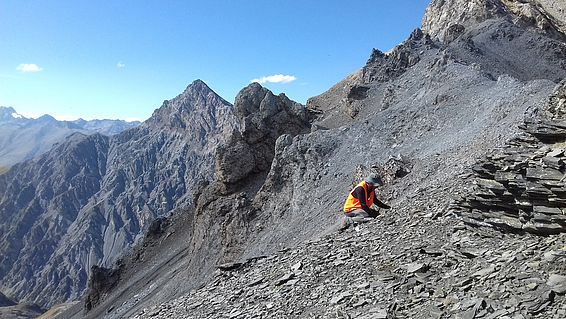27.07.2022 | Beate Kittl | News WSL
Beetles, millipedes or ants are hugely important for the functioning of soils. This is especially true in mountain forests, which are being particularly affected by climate change. The Swiss Federal Institute for Forest, Snow and Landscape Research WSL and the University of Basel have now jointly investigated how soil fauna diversity has evolved and been distributed across the altitudinal zones.
Quite a lot of research has been done on plant occurrences in mountains, but little on soil-dwelling animals. "The fauna groups we studied are relevant to ecosystem functioning, and some of them have important roles in nutrient cycling, such as millipedes, or in relation to soil structure, such as soil-dwelling ants," says co-author Stephan Zimmermann of WSL's Soil Functions and Protection research group. He further points that these groups are representative of numerous other arthropod groups: spiders are predators, while millipedes break down litter to provide nutrients.
The Alps are particularly affected by climate change, and these small animals cannot migrate easily. A research team from WSL and the University of Basel has now studied organisms such as spiders, centipedes, millipedes and various beetles to better understand their occurrence at different altitudes.
The Swiss National Park has been largely untouched by humans since as early as 1914. Therefore, it was ideally suited for this study. At elevations ranging from 1800 to 2750 meters, the research team captured over 14,000 individuals by eye search or by artificial shelters and ground traps. They belonged to altogether 248 species from six animal groups: spiders, ground beetles, centipedes, millipedes, rove beetles and ants.
The altitude counts ¶
Next, the researchers used statistical methods to look for patterns in the altitude distribution and found three distinct ones: a steady decrease with increasing altitude (centipedes), a constant number and then a rapid decrease at high altitudes (ants and rove beetles), and a peak in the number of species at medium altitudes combined with a decrease at high altitudes (spiders and millipedes). The number of species and where they occurred depended almost exclusively on altitude for all animal groups. Most other soil and vegetation characteristics had little influence because they themselves depended on elevation, the researchers report in the journal PLOS ONE. They mention as noteworthy that the patterns are very disparate. "Looking at just one group can yield misleading results for species diversity as a whole," Zimmermann says. The authors recommend that future studies of elevation should always consider multiple species groups.
Mountains strongly affected by climate change ¶
In the context of climate change, this study provides valuable baseline data on the occurrence of soil invertebrates at high elevation. "Mountain species are strongly affected by the ongoing climate warming, because the increase in temperature is higher than average there," says Zimmermann. Many animal and plant species are shifting their distribution to higher elevations, where habitat is scarce. For the species living there, competition for food and habitats increases. Since alpine soils take a long time to develop or to recover after disturbances, a well-functioning soil fauna is particularly important for them.
Always up to date: Subscribe to WSL Newsletter
Contact ¶
Contacts Uni Basel ¶
Dr. Brigitte Braschler
brigitte.braschler@unibas.ch
Prof. em. Dr. Bruno Baur
bruno.baur@unibas.ch
Publications ¶
Copyright ¶
WSL and SLF provide the artwork for imaging of press articles relating to this media release for free. Transferring and saving the images in image databases and saving of images by third parties is not allowed.

